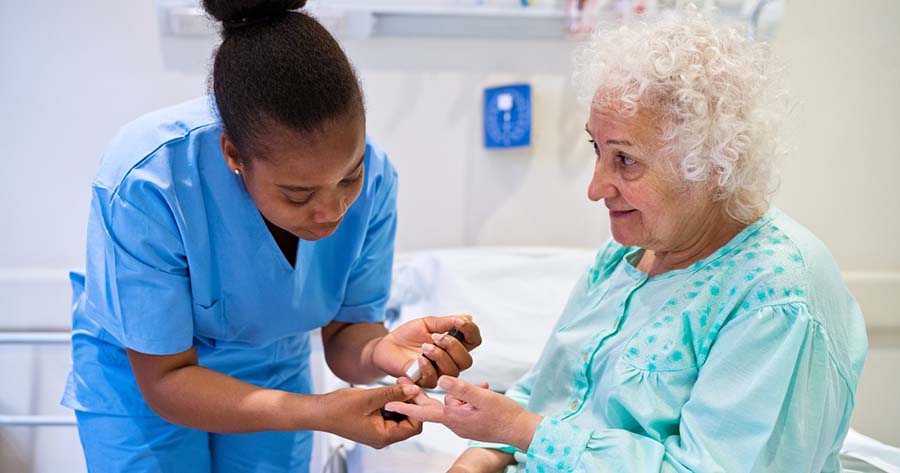Obstructive sleep apnoea (OSA) is a condition that causes interrupted breathing during sleep, and is associated with diabetes and obesity. OSA and type 2 diabetes (T2D) are independently linked to high cardiovascular morbidity and mortality (UKPDS Study Group, 1998; Stratton et al, 2000; Peker et al, 2002). OSA is also linked to drug-resistant hypertension (Logan et al, 2001), increased insulin resistance (Punjabi et al, 2002) and obesity (Mun et al, 2001) – all recognised problems for people with T2D. In addition, the resultant daytime sleepiness is known to be responsible for vehicle and occupational accidents (IMPRESS, 2009) and can seriously affect quality of life (Lacasse et al, 2002).
The prevalence of OSA in the general male population is approximately 4–9% (Young et al, 1993); however, studies have suggested that as many as 49% of men and 21% of women with T2D have moderate OSA (Einhorn et al, 2007). This figure is likely to increase with the estimated rise in the prevalence of obesity to 65 million adults in the USA and 11 million adults in the UK by 2030 (Wang et al, 2011).
In 2008 the International Diabetes Federation (IDF, 2008) published its consensus statement on OSA and T2D (Box 1) and there have been further studies highlighting the links between the two conditions. So why, as healthcare professionals caring for people with diabetes, are we not routinely trying to identify whether our patients have OSA? Is it a lack of recognition of OSA as a serious condition and not just a noisy inconvenience for spouses? Or a lack of available training? Or the belief that treatment with continuous positive airway pressure (CPAP) is poorly tolerated?
This article looks at the links between OSA, the metabolic syndrome and T2D, and suggests ways to use effective screening and raise awareness of this condition through educational initiatives, to improve individuals’ quality of life and reduce cardiovascular and other serious diabetes-related complications.
Background
OSA presents the healthcare professional with two problems: first, the physical and metabolic health problems associated with sleep apnoea; and second, the consequences of sleep deprivation. To appreciate the severity of the problem it is necessary to understand the functions of sleep as restorative, promoting growth and reducing cardiovascular work.
OSA is classified as repeated episodes of airway obstruction, each lasting at least 10 seconds, resulting in hypoxia (desaturation of ≥4%) and micro-arousal during sleep. During these episodes of micro-arousal there is increased sympathetic nervous system activity, resulting in a release of the counter-regulatory stress hormones catecholamines and cortisol and subsequent rise in blood pressure and heart rate. In the long-term this leads to increased insulin resistance, weight gain and cardiovascular disease (Peker et al, 2002), as well as congestive cardiac failure (Oldenburg et al, 2007), cerebrovascular accident and drug-resistant hypertension (Logan et al, 2001). There are also higher rates of maculopathy (Mason et al, 2010) and a suggested increased rate of retinopathy (West et al, 2010) in people with T2D.
OSA is usually associated with obesity (Lopez et al, 2007), particularly around the neck and chest, leading to a collapse of the airway, but is also linked to anatomical abnormalities such as large tonsils or a large tongue, as in people with Down’s syndrome. OSA is also more common in people with diabetic autonomic neuropathy (Ficker et al, 1998). OSA severity is based on the number of apnoeic and hypopnoeic episodes per hour of sleep – the apnoea–hypopnea index (AHI). It is calculated by dividing the total number of apnoeic episodes per night by the number of hours sleep. For example, 200 episodes divided by 6 hours of sleep gives an AHI score of 33. A score of 6–15 is mild; 16–30 is moderate; and >30 is severe OSA.
Prevalence of OSA and T2D
As previously described, the current diagnosed prevalence of OSA in the general male population is 4–9% (Young et al, 1993). However, this figure is likely to rise with the rapid increase in obesity, confirmed by Lopez et al’s (2007) study that demonstrated an OSA prevalence of 71% in people with a BMI of 35–39.9 kg/m2. In addition, evidence suggests that 80% of people with OSA have the metabolic syndrome and approximately 15% have T2D (Reichmuth et al, 2005).
Einhorn et al’s (2007) study demonstrated that 49% of men and 21% of women with T2D have moderate OSA (AHI >15). As yet, the exact mechanism linking OSA to glucose intolerance has not been confirmed, but is believed to be, in part, associated with the sympathetic nervous system’s activity stimulated by the multiple micro-arousals caused by OSA (Oltmanns et al, 2004)
Symptoms and screening
OSA is a serious medical condition that has both acute consequences and long-term complications. These include snoring, fragmented sleep, choking arousals, non-refreshing sleep, morning headaches, daytime somnolence (sleepiness) and occupational and motor vehicle accidents related to fatigue. It could also be argued that the changes in hormone levels (reduction in leptin and an increase in ghrelin) associated with insufficient sleep lead to an increase in appetite and subsequent weight gain (Spiegel et al, 2004).
Many people with mild to moderate OSA will not be aware of any symptoms or will put them down to “working too hard” or simply getting older, or may even link them to their diabetes. If an individual reports symptoms, the GP should perform a clinical assessment to identify if they are at increased risk of OSA (Table 1).
In addition, it may be helpful to use the Epworth Sleepiness Score (Johns, 1991), in which people rate the likelihood of dozing off or falling asleep in certain situations (Table 2). A score of >10 indicates potential sleep disordered breathing and a score >15 warrants urgent referral to a sleep specialist. There are other recognised sleep scores that can be used, such as the Berlin Score (Netzer et al, 1999) or the STOP BANG Score (Chung et al, 2008). Further comparative studies need to be undertaken to assess which is the most effective for people with diabetes.
Diagnosis
Following referral to a sleep physician, individuals will usually be given a portable pulse oximeter to wear overnight at home. Alternatively they may be fitted with a more advanced apnoea meter that straps around the chest and collects data on airflow, heart rate and oximetry.
If either of these demonstrates a drop in blood oxygen saturation levels, then the diagnosis is usually confirmed by undergoing sleep studies known as polysomnography (PSG). PSG is the agreed standard for diagnosing OSA and consists of recording an extensive range of physiological parameters while a person sleeps, including electroencephalogram (EEG), electrocardiogram (ECG), electrooculogram (EOG – a measure of eye movement), airflow from the nose and mouth, respiratory effort measured with elastic belts around the chest and the abdomen, and oximetry.
Treatment
The treatment options for OSA include:
- Lifestyle advice on weight loss, increasing exercise, reducing alcohol intake, stopping smoking, positional sleeping and good sleep hygiene.
- Dental appliances – mandibular advancement devices.
- Mechanical – CPAP and automatic positive airway pressure (APAP) therapies.
- Surgery for physiological abnormalities.
CPAP is the most common treatment option for OSA, but all people with the condition should also receive lifestyle advice to maximize the health benefits. Sengul et al (2009) demonstrated that exercise reduced the severity of OSA with a reduction in the AHI score, although body weight and BMI remained unchanged. In contrast, the Sleep AHEAD (Action for Health in Diabetes) study (Foster et al, 2009) looked at the effect of weight loss on OSA in people with T2D and demonstrated that a weight loss of more than 10 kg was needed to reduce the severity of OSA.
NICE (2008a) recommends CPAP as a treatment option for adults with moderate or severe symptomatic OSA. CPAP is only recommended for adults with mild OSA if they have symptoms that affect their quality of life and ability to go about their daily activities, and lifestyle advice and other relevant treatment options have been unsuccessful or are considered inappropriate.
Benefits of CPAP
The benefits of CPAP treatment in moderate to severe OSA are well documented:
- Reducing daytime sleepiness (Patel et al, 2003).
- Improving quality of life for the person with OSA and their sleeping partner (Parish and Lyng, 2003).
- Reduction in road traffic accidents by 83% (George, 2001).
- Lowering blood pressure – a reduction in mean arterial blood pressure of 10 mmHg and a greater reduction in people with severe OSA (Becker et al, 2003).
- Reducing cardiovascular risk – coronary heart disease event risk reduced by 37% and stroke risk reduced by 56% (Becker et al, 2003).
- Reducing long-term health costs after a 2-year treatment period (NICE, 2008b).
- Raising HDL-cholesterol after 6 months of therapy (Börgel et al, 2006).
- Increasing insulin sensitivity (Harsch et al, 2004)
- Possible improvement in visual acuity in people with diabetic macular oedema (Mason et al, 2010).
- Possible improvement in glycaemic control (Babu et al, 2005).
The issue of whether CPAP improves glycaemic control is still under review, with only a handful of studies to-date being able to show a positive link. Babu’s (2005) study of 25 morbidly obese people (BMI 42.7±8.7 kg/m2) with T2D and moderate to severe OSA (AHI=56±37) showed a significant drop in all postprandial blood glucose levels (e.g. post-breakfast 10.6±3.8 mmol/L to 7.2±2.3 mmol/L) after a minimum of 3 months CPAP treatment (without any relevant change in diabetes therapy), and a reduction in HbA1c level of 0.6% (6.6 mmol/mol).
The study by Babu et al (2005) was small and the improved glycaemic control was strongly dependent on participants using CPAP for at least 4 hours per night. The published findings did not state whether participants received any lifestyle advice or whether there had been any weight loss which may have influenced the improved glycaemic control. It is widely acknowledged that more research is needed to prove a definite improvement in glycaemic control with CPAP.
Long-term adherence to CPAP
There has been a long-held belief that CPAP therapy is poorly tolerated by people with OSA, which may lead to clinicians being hesitant about referring these individuals. In McArdle et al’s (1999) 11-year study of 1211 people (not specifically with T2D), 4.5% refused to try CPAP. Of those who started it, 20% stopped treatment within a few months, but 68% were continuing to use the treatment after 5 years. The independent predictors of long-term CPAP use were snoring history, AHI and high Epworth score, with 86% of participants with an AHI of 30 and an Epworth score >10 still using CPAP at 3 years. In addition, a high average nightly CPAP use within the first 3 months was strongly predictive of continued long-term use.
Over the past 12 years since McArdle et al’s (1999) study there have been huge improvements in the design of CPAP machines and there has been an increased use of APAP machines which automatically adjust the air pressure according to the individual’s needs. Therefore, it is highly likely that adherence rates will have increased and clinicians must not let their outdated prejudices affect their decision to refer people with suspected OSA. Anecdotal evidence from the specialist nurse running the CPAP clinic at Brighton and Sussex University Hospitals Trust suggests that adherence is linked to perceived and real benefit for and by the person with OSA. She also stated that adherence among people over 70 years of age is often poor (Eason, 2011, personal communication), but had no patient feedback data to confirm the reason for this.
Considerations for people with T2D
Apart from the benefits of reducing the long-term risk of cardiovascular disease and other complications associated with OSA, there are other factors that healthcare professionals need to consider in the management of people with T2D and whether to screen for OSA.
Many people with T2D often require two or three pharmacological agents to manage their hypertension – this could be an indication of OSA and will improve if the OSA is treated successfully. Consideration should be given to screening people with T2D who also have autonomic neuropathy and/or hypothyroidism, because OSA is more common in these groups.
A study by West et al (2010) suggested that OSA had a far stronger relationship with retinopathy than glycaemic control or high blood pressure. Further research is therefore needed to determine whether successful treatment of OSA would reduce the severity and rate of deterioration of retinopathy and macular oedema. People with severe OSA taking the erectile dysfunction drug sildenafil may need to have this medication reviewed as it can cause the throat muscles to relax.
Educational initiatives
OSA sessions at national and international conferences and specialist meetings are a starting point, but alone they are not enough. Following a quick review of five leading universities in the UK, the author was unable to find any reference to OSA in the diabetes MSc course syllabus of any of these universities, and this needs to be addressed. Furthermore, the author believes that initiating screening should be a primary care responsibility because the majority of people with T2D receive their diabetes care from their GP and practice nurse. Therefore, educational initiatives need to target primary healthcare professionals with local seminars and study days. The author is in the process of organising a locality-wide, practice-based training programme and audit to encourage the screening of all high-risk people with T2D for OSA and vice versa. People with diabetes also need to be made aware of the links between T2D and OSA. Disappointingly, the Diabetes UK website has no mention of OSA, even in its section on “other associated conditions”.
A public health priority
The author believes that following the improvement in diabetes care with the implementation of the GMS contract and the Quality and Outcomes Framework (QOF) in 2004 (Calvert 2009), screening for OSA in people at high risk, including those with T2D, should be added to the QOF indicators and would then become part of the diabetes annual review. No one questions the inclusion of screening for diabetic neuropathy, which has a prevalence of 20% in people with T2D (Shaw and Zimmet, 1999), whereas OSA has a prevalence of 48% in men with T2D. Diabetes leaders should work with NICE and the independent Primary Care QOF Indicator Advisory Committee in implementing this initiative. They also need to devise a National Service Framework similar to that in Northern Ireland where there is an OSA Strategic Framework for Respiratory Conditions which states that “All adults with a clinical suspicion of having obstructive sleep apnoea/hypopnoea syndrome (OSAHS) should have investigation at a specialist OSAHS service led by a respiratory physician” (Department of Health, Social Services and Public Safety, 2011).
Conclusion
It is the responsibility of healthcare professionals to provide evidence-based care for patients, and the field of diabetes is no exception. Pharmaceutical regulators, such as the European Medicines Agency, monitor drugs closely for unacceptable side-effects. In March of this year rosiglitazone was withdrawn from the market following a study that found patients taking the drug were 23% more likely to suffer congestive heart failure and 16% more likely to have a myocardial infarction (Loke et al, 2011). Clinicians welcome such action to ensure no harm comes to their patients. So why, in the face of so much evidence linking OSA to cardiac ischaemia, hypertrophy, arrhythmias and ultimately cardiac failure, are we not putting into place strategies that target OSA identification and treatment for people
with T2D?
In today’s budget-restricted NHS it would not be feasible or appropriate to refer everyone with T2D for PSG or even portable pulse oximetry, but targeted screening of those at highest risk, as determined by a clinical assessment and using a sleep assessment score, would identify those most at risk of developing OSA. Those who were diagnosed with OSA would benefit from CPAP, a treatment that is acknowledged and approved by NICE (2008b) due, in part, to its proven reduction in long-term health costs after only a 2-year period of use.
By specialist diabetes and respiratory teams working together to implement effective local educational initiatives and by government policymakers assisting primary care to set up targeted screening, the author believes that many more people would be diagnosed and subsequently have their OSA successfully treated, improving both their diabetes and OSA health outcomes, and significantly improving their quality of life.
Acknowledgements
With special thanks to Debbie Eason, Respiratory and CPAP Specialist Nurse, Brighton and Sussex University Hospitals Trust; Andy Smith, Consultant Physician, Brighton and Sussex University Hospitals Trust for being my mentor; and Jill Hill, Diabetes Nurse Consultant, Birmingham for encouraging me to write this article.





Key scientific developments presented at the conference.
6 Aug 2025